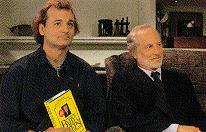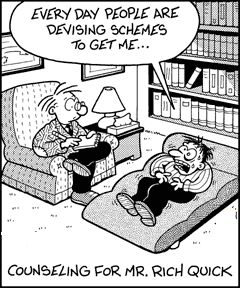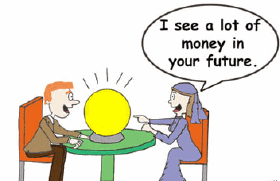 All Entries in the "Trading Psychology" Category
All Entries in the "Trading Psychology" Category
Little Things
March 29, 2006 at 12:36 pm
 Here’s one for all of you human calculators. A trader starts out with only $5,000 in his account, but is able to gain .5% each trading day. (That’s just ½ of 1% per day.) The first day he’d only make $25 profit, but how much would he have after 5 years?
Here’s one for all of you human calculators. A trader starts out with only $5,000 in his account, but is able to gain .5% each trading day. (That’s just ½ of 1% per day.) The first day he’d only make $25 profit, but how much would he have after 5 years?
$100,000? $500,000?
Would you believe it’s over $3,000,000.00? Wow! I’d say that little things make a big difference!
Have you examined your habits lately? They can have a giant impact on your trading results, so it’s worth taking a closer look at them.
Obeying stops is one habit we can all be reminded to check. It’s easy to “just give it a little more room” and soon after realize that you’re in a spot where you feel it’s too late to exit (which is never true). Doing your homework is always a great habit to be in. Showing up with your game face is another one. Remember how small mistakes = small consequences? Habits like those can keep you on the right track as a trader and pay off nicely as time goes by. Making a habit just to show up prepared every day for whatever the market throws at you can have a tremendous impact on your progress and consistency as a trader….not to mention your P&L!
Eating a bowl of ice cream late tonight won’t make you fat, but make it a habit and soon your pants start getting tight! The little things you do can add up to big differences over time. Acorns grow into great big oaks…..and your trading account can be the same way. Take a look at your habits and how they’re affecting your trading results. Keep the ones that are helpful. But like the garage this time of year, clean out those which are hindering your progress!
Jeff White
President, The Stock Bandit, Inc.
www.TheStockBandit.com
The Flip Side
March 23, 2006 at 8:08 am
You’ve probably heard the phrase, “you’re not trading the stock, you’re trading the people on the other side of the stock.” It’s a valid point that I can agree with to an extent.
As much as you might follow a trading strategy, there will likely be emotions to battle while you’re in the middle of a trade. Almost every trade will have some fear and greed associated with it, but the memorable trades are really packed with emotion on both sides. Keeping close tabs on your emotions while maintaining some awareness of what your competition is facing can greatly help you improve your exit timing as well as your P&L.

Meet paranoid trader Rich Quick
As traders, it’s certainly important to understand which emotions are impacting those on the other sides of our trades. For example, If I’m long XYZ stock and I’m losing money, the trader who’s short XYZ may well be getting greedy. As a result, he’s probably in no hurry to buy back the stock (which would help to support price and help out my trade). Knowing this and staying aware of it during the trade would remind me that I am probably better off taking the small loss and moving on to the next trade rather than making matters worse. I can always wait for a better spot and re-enter if I still like the trade.
In another example, say I buy ABC stock on a reversal play off of support. The trader who sold it to me is likely short the stock, and once ABC catches a bid, I know he’s in trouble. As momentum picks up steam, I might offer some out into the strength, but I’ll be looking to ride that stock further just knowing the emotions and disbelief that those on the other side of my trade are dealing with. Ultimately, they’ll capitulate and drive my trade higher, allowing me to capture greater gains.
Consider your own emotions during a trade, but also the emotions of those on the other side of the trade. Even a quick rundown of what the guy on the other side of your trade must be feeling could prevent further losses or help you maximize an already successful trade.
Remember to subscribe to this feed so you won’t ever miss a post!
Jeff White
The Stock Bandit, Inc.
www.TheStockBandit.com
The View From the Hammock
March 13, 2006 at 10:03 am
Trading requires lots of “knowing when’s.” Knowing when to buy is as important as knowing when to sell. Knowing when to trade big is as important as knowing when to cut back on your position size. And knowing when to be active is as important as knowing when to walk away from the screens and do nothing.
The market is in a tough spot right now from a trading standpoint. There are not a lot of good setups for initiating new trades, and that leaves only two choices: either lower your standards for what comprises a good setup, or be willing to sit on your hands and wait for better opportunities.
On Tuesday and Friday of this past week, I chose to stand aside. I had no swing trading candidates in my newsletter. They just weren’t there!
There were a few reasons for this. First of all, the market is stuck in a trading range and it lacks a trend (this alone leaves fewer setups with so many stocks stagnant). Secondly, there were no stocks that jumped out at me after running my scans and searching the lists that I couldn’t live without. And finally, I’ve been seeing fewer stocks find follow through out of good bases.
As a result, I was able to set my entry orders and stops and tend to other matters during those two trading days (like taxes – UGH!). While I would have much rather been trading heavily and watching things run, the odds were that dips would be bought and rallies would be sold. It turns out that’s about what we got.
When you run your screens and you come up with nothing to trade other than some decent-looking patterns, be willing to pass entirely. The trading year is long, and there’ll be PLENTY of times to be active in the market.
Sacrificing quality trades for quantity seems to lead to losing streaks for me (and commissions for my broker), so I’d personally just rather preserve capital, manage existing positions, and get some other items crossed off my to-do list. I know that the market conditions will improve, and when it does, I’ll need my full ability to focus!
Jeff White
President, The Stock Bandit, Inc.
www.TheStockBandit.com
Seeing the Future?
March 9, 2006 at 5:35 pm
It would be nice to have a crystal ball. But that’s not what trading is all about. Timing is everything. Although we might accurately predict the next move of a stock or the market itself, as traders we must still place the corresponding orders to enter and exit positions at the right times and in the right directions in order to profit. Simply understanding the direction to trade in won’t help you near as much as knowing when to get in and when to get out.
While I think it’s important to be able to locate and use chart patterns and technical analysis for trading, I sure don’t think a trader’s ability to tell the future (or backtest the past) will make him a profitable trader. Chart pattern recognition is certainly helpful to traders, but what about execution? What about psychology and knowing when to ride out a pullback versus recognizing a reversal and knowing when to bail out? The learning curve can be steep. Some things you just have to learn by trading.

Don’t get tied up trying to hone your prediction skills! Every trader is going to go through times of being right and being wrong. Successful trading is about damage control when you’re wrong and pressing it when you’re right. What’s most important is staying in sync with the market and adjusting your trading size and frequency at the right times in order to maximize your profitability.
Jeff White
President, The Stock Bandit, Inc.
www.TheStockBandit.com
Backtesting
March 8, 2006 at 4:38 pm
It has become an everyday word……backtesting. You can hardly avoid seeing it, because so many marketing efforts are convincing traders during this choppy market that backtesting is the magic bullet for successful trading. I’m not so sure I agree.
Maybe a PC tells you that a given trading system would have made or lost X dollars over the past 6 months. So what? Isn’t the market always in motion, always changing? If it is so easy to just figure out what worked over the past month and apply it toward the coming month, then wouldn’t the market be showing us some phenomenal trends right now with everyone pushing stocks in the same direction rather than the back-and-forth choppy action we see so much of?
Instead, we’re getting a LOT of program trading that keeps things choppy as dips are bought and rallies are sold. With the trendless market, it has truly become a market of stocks. Good swing trading right now is about doing your homework to locate good technical patterns and then keeping your risk/reward in check.
Don’t let glossy advertising from software vendors fool you into thinking that your trading strategy just isn’t complicated enough. Remember Gartman’s rule and the simplicity it offers. Keep tabs on the market environment and adjust your trading plan accordingly. If a good trend exists, then look for some continuation setups like flag patterns and triangle patterns. If prices are stuck in a range, then consider some reversal setups like the double top or trade a channeling stock. Your ability to adapt to existing conditions is what will add to your P&L, not your ability to backtest effectively.
Successful trading is about recognizing what kind of market you’re in and how to trade it most effectively, even if it means that you stand aside at times. Hoping that you could spend the next long weekend backtesting a magic formula based on past conditions may just be a shortcut that will only leave you more frustrated.
Jeff White
President, The Stock Bandit, Inc.
www.TheStockBandit.com
Don’t Forget Your Game Face
January 30, 2006 at 2:00 pm
Bring your very best or don’t show up at all. That’s the attitude to have when it comes to many competitive activities, and trading is definitely one of them.
Last week, Kobe Bryant put up 81 points one night. Now, I’m actually a Spurs fan (and we don’t like the Lakers!), but I couldn’t help but be impressed by Kobe’s performance. Without question, Kobe had his entire focus on doing his job to the best of his ability. Every time he got the ball, he was on a mission. His focus kept him from being distracted by anything else. Marital problems? Nah. Tabloid rumors? Nope. Disputes with the coach? No way. He had his game face on and nothing stopped him.

Tiger Woods shows up ready to play every time out, and he stays home otherwise. Think about what an approach like that could do for your trading results!
Take the same approach with trading. The first thing I try to consider each day is how do I feel. Physically, it’s important to be healthy and alert, but a quick mental check will help you to determine how you should trade today, if at all.
If you’ve got off-the-court issues bothering you, don’t get in the game. If doing those taxes late last night left you with your head in a fog today, you shouldn’t be trading. If one of your relationships is rocky and you can’t commit your concentration to trading, then today probably won’t be your day to trade. If you have family in town visiting and you feel obligated to entertain, then your trading is going to suffer.
Priorities like health, family and relationships, and a to-do list longer than you prefer can often mean sub-par trading results. Consider sitting on your hands during those times when your situation leaves you with less than 100% focus. A little patience with priorities never hurt anyone. And when you return to trading, make sure you bring your game face!
Jeff White
President, The Stock Bandit, Inc.
www.TheStockBandit.com
Another Definition of Trading
January 23, 2006 at 6:20 pm
 Most people think that trading is the buying and selling of stocks. I suppose it is, but I often say that trading is the continual process of making and losing money. This is true! A trader’s success all boils down to making more when he’s right and losing less when he’s wrong. What matters is the difference between how much you make and how little you give back!
Most people think that trading is the buying and selling of stocks. I suppose it is, but I often say that trading is the continual process of making and losing money. This is true! A trader’s success all boils down to making more when he’s right and losing less when he’s wrong. What matters is the difference between how much you make and how little you give back!
I’m right more often than I’m wrong, but that wouldn’t necessarily have to be the case for me to make money. By managing trades properly, a trader could be 50/50 or even worse and still come out profitably. It’s about taking small losses and sticking with the winning trades to overcome the small losses.
Knowing that I’ll be wrong certainly helps me to accept a losing trade. Every day when I settle into my routine, I’m aware that I will probably have at least one losing trade – but that doesn’t stop me from trading (or making money). That awareness doesn’t hurt my confidence, but instead it keeps my ego suppressed. I know that I’ll be wrong, so when I am, it’s far easier to hit the sell button and wipe that small mistake off my screen. Then I can focus on my winning stocks without the eyesores and annoyances of stocks moving opposite of what I had anticipated.
Don’t let your ego interfere with your trading! Going to battle with a losing trade by adding to it or simply letting the truck roll over you without getting out of the way are all due to ego. Accept that there will be some losses, commit to keeping them small, and stay focused on getting the most out of your winning trades.
Follow my trades and see how I manage both winners and losers with a 2-week trial to my swing trading service. You’ll like the net result!
Jeff White
President, The Stock Bandit, Inc.
www.TheStockBandit.com





